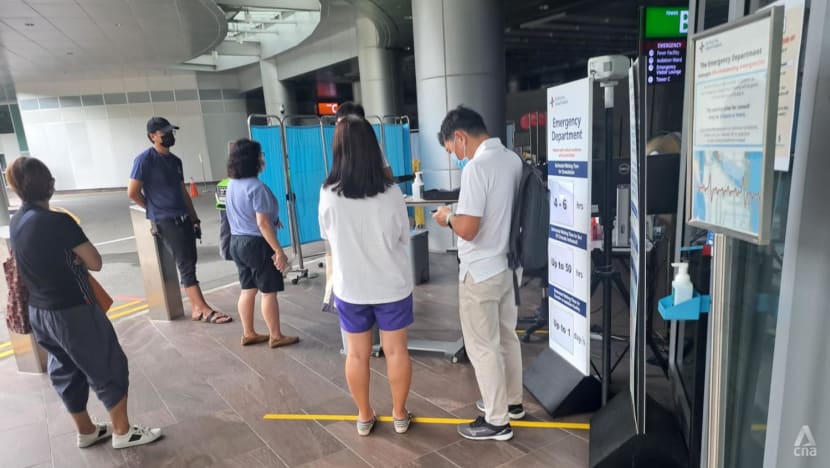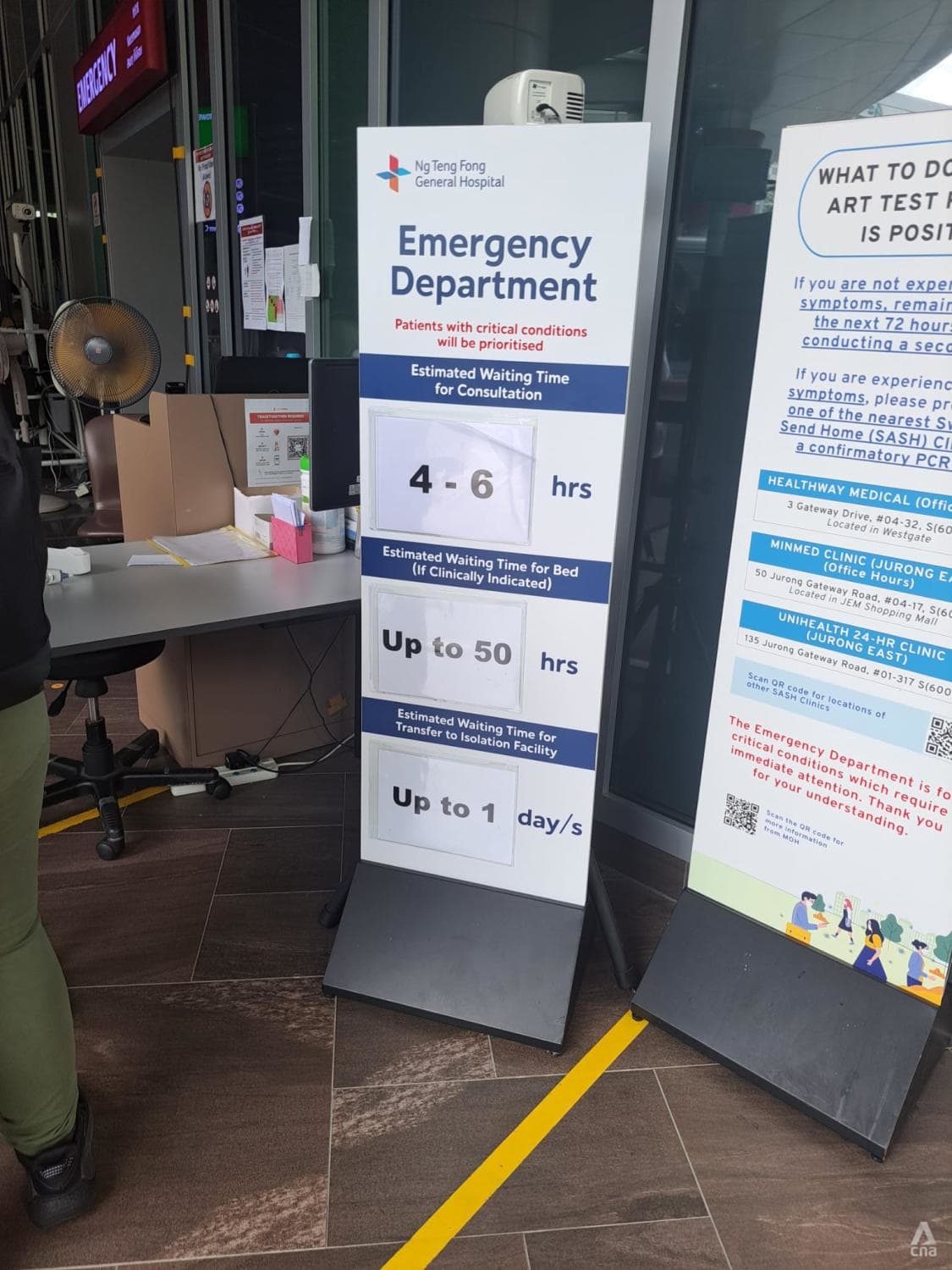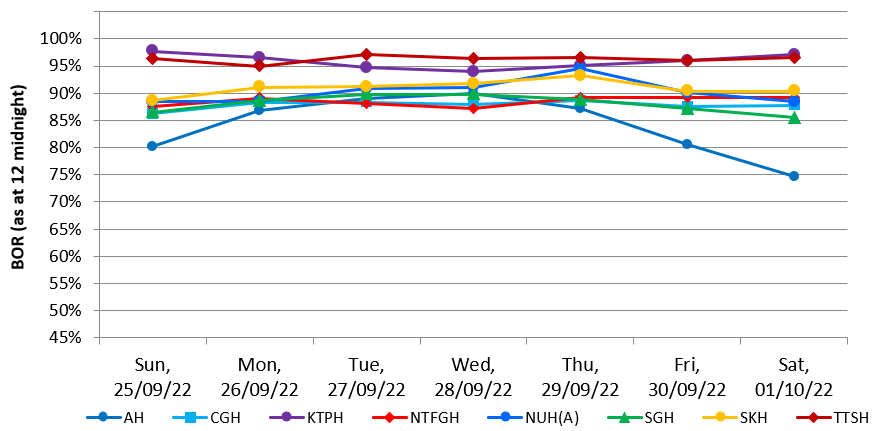www.channelnewsasia.com
Singapore
 People waiting outside Ng Teng Fong General Hospital's emergency department on Oct 19, 2022. (Photo: CNA reader)
People waiting outside Ng Teng Fong General Hospital's emergency department on Oct 19, 2022. (Photo: CNA reader)
20 Oct 2022 06:00AM (Updated: 20 Oct 2022 06:32AM)
SINGAPORE: The waiting time for admission has surged to as high as 50 hours at some hospitals as of Wednesday (Oct 19), as public emergency departments across the country continue to see a high number of patients.
Ng Teng Fong General Hospital and Sengkang General Hospital were among those with waiting times of up to 50 hours, according to family members of patients and healthcare workers CNA spoke to.
 A sign outside Ng Teng Fong hospital's emergency department on Oct 19, 2022, stating that waiting times could take up to 6 hours for a consultation and 50 hours for a bed. (Photo: CNA reader)
A sign outside Ng Teng Fong hospital's emergency department on Oct 19, 2022, stating that waiting times could take up to 6 hours for a consultation and 50 hours for a bed. (Photo: CNA reader)
This is higher than the latest data available from the Ministry of Health's website, which showed that the median waiting time for admission to wards from emergency departments was between one hour and 24.2 hours for the week of Sep 25.
Data for Oct 2 onwards has not been released yet.
CNA has contacted both hospitals for more information.
 A chart showing the daily median waiting time for admission at emergency departments tracked by the Ministry of Health from Sep 25 to Oct 1.(Source: MOH website)
A chart showing the daily median waiting time for admission at emergency departments tracked by the Ministry of Health from Sep 25 to Oct 1.(Source: MOH website)
One man, who wanted to be known only as Mr Ng, said his mother had to wait 25 hours for a bed, after being brought to Ng Teng Fong General Hospital by ambulance on Tuesday afternoon because her legs started swelling.
Due to stricter safe management measures, he was not allowed to accompany his mother, who is 100 years old, inside.
“I’m very worried because I couldn't go in with her and speak to the doctor to tell them about her dietary needs and conditions,” said the 70-year-old in Mandarin, adding that his mother has advanced dementia.
According to Mr Ng, a doctor eventually called him an hour later to find out more about his mother’s condition over the past few days and said that she was currently stable.
“(At the time) they said they would only update me once she gets a bed, so I think she was put up at the A&E ward. I was worried that she might be cold there and whether anyone would give her a blanket or feed her,” he said. "It was just a lot of waiting."
According to Ms Lim, it took nearly 20 hours before her mother was admitted to a ward. While waiting for an available bed, her mother was put up at the hospital’s Ambulatory Surgery Centre.
“It was very crowded and noisy there and from what I could see, there were a lot of patients with their beds pushed closely to one another and it spilled over to the main walkways as well,” said Ms Lim.
Among hospitals tracked by the Ministry of Health, latest figures show that daily bed occupancy rates ranged from 74.7 per cent to 97.6 per cent between Sep 25 and Oct 1.
 Daily bed occupancy rates at hospitals tracked by the Ministry of Health from Sep 25 to Oct 1. (Source: MOH website)
Daily bed occupancy rates at hospitals tracked by the Ministry of Health from Sep 25 to Oct 1. (Source: MOH website)
The ongoing bed crunch could also be due to an increase in patients with severe conditions, according to healthcare workers CNA spoke to.
“A lot of older people didn't go to see a GP doctor or get their medications refilled during the COVID-19 pandemic, and just let it lapse for whatever reason,” said one senior doctor who works at a public hospital.
“So the patients who are coming in are sicker and because of that, they have to stay in the hospital.”
Manpower constraints at her hospital have also been exacerbated by the current wave of COVID-19 cases, with more staff members testing positive for the virus.
“A lot of junior doctors are getting sick and because there's so many of them that are sick, there's nobody to recall. So then seniors end up having to cover them,” she said. “It’s a vicious cycle and just feels endless, so we all feel very exhausted.”
Healthcare workers interviewed for this story were not identified as they were not authorised to speak to the media.
A junior doctor CNA spoke to said the average waiting time at the public hospital he works at was about one day.
He said the longer wait could be due to a combination of factors, including the ongoing flu season and the spike in COVID-19 cases. But he added that even before this, hospitals have been packed.
A Ministry of Health spokesperson told CNA that emergency departments have been seeing a high number of patients for a few months. While most patients have conditions not related to COVID-19, the rising infection caseload exacerbates the situation.
“All cases presenting at the ED are triaged and priority care will continue to be given to critically ill patients at the ED,” said the spokesperson.
The ministry urged members of the public to go to the hospital emergency departments only for emergencies.
“We also appeal to everyone to play their part in alleviating the load on our public hospitals by visiting the general practitioner or polyclinic doctor first if they are experiencing mild respiratory symptoms and/or non-life-threatening conditions,” it said.
Singapore
Longer waiting times at hospitals with some patients waiting up to 50 hours for a bed
Ng Teng Fong and Sengkang hospitals were among those with wait times of more than two days, according to patients and healthcare workers.
20 Oct 2022 06:00AM (Updated: 20 Oct 2022 06:32AM)
SINGAPORE: The waiting time for admission has surged to as high as 50 hours at some hospitals as of Wednesday (Oct 19), as public emergency departments across the country continue to see a high number of patients.
Ng Teng Fong General Hospital and Sengkang General Hospital were among those with waiting times of up to 50 hours, according to family members of patients and healthcare workers CNA spoke to.

This is higher than the latest data available from the Ministry of Health's website, which showed that the median waiting time for admission to wards from emergency departments was between one hour and 24.2 hours for the week of Sep 25.
Data for Oct 2 onwards has not been released yet.
CNA has contacted both hospitals for more information.

One man, who wanted to be known only as Mr Ng, said his mother had to wait 25 hours for a bed, after being brought to Ng Teng Fong General Hospital by ambulance on Tuesday afternoon because her legs started swelling.
Due to stricter safe management measures, he was not allowed to accompany his mother, who is 100 years old, inside.
“I’m very worried because I couldn't go in with her and speak to the doctor to tell them about her dietary needs and conditions,” said the 70-year-old in Mandarin, adding that his mother has advanced dementia.
According to Mr Ng, a doctor eventually called him an hour later to find out more about his mother’s condition over the past few days and said that she was currently stable.
“(At the time) they said they would only update me once she gets a bed, so I think she was put up at the A&E ward. I was worried that she might be cold there and whether anyone would give her a blanket or feed her,” he said. "It was just a lot of waiting."
It was a similar situation to what Ms Evelyn Lim experienced two weeks ago, when she brought her 73-year-old mother to Singapore General Hospital for suspected internal bleeding.According to Ms Lim, it took nearly 20 hours before her mother was admitted to a ward. While waiting for an available bed, her mother was put up at the hospital’s Ambulatory Surgery Centre.
“It was very crowded and noisy there and from what I could see, there were a lot of patients with their beds pushed closely to one another and it spilled over to the main walkways as well,” said Ms Lim.
Among hospitals tracked by the Ministry of Health, latest figures show that daily bed occupancy rates ranged from 74.7 per cent to 97.6 per cent between Sep 25 and Oct 1.

The ongoing bed crunch could also be due to an increase in patients with severe conditions, according to healthcare workers CNA spoke to.
“A lot of older people didn't go to see a GP doctor or get their medications refilled during the COVID-19 pandemic, and just let it lapse for whatever reason,” said one senior doctor who works at a public hospital.
“So the patients who are coming in are sicker and because of that, they have to stay in the hospital.”
Manpower constraints at her hospital have also been exacerbated by the current wave of COVID-19 cases, with more staff members testing positive for the virus.
“A lot of junior doctors are getting sick and because there's so many of them that are sick, there's nobody to recall. So then seniors end up having to cover them,” she said. “It’s a vicious cycle and just feels endless, so we all feel very exhausted.”
Healthcare workers interviewed for this story were not identified as they were not authorised to speak to the media.
A junior doctor CNA spoke to said the average waiting time at the public hospital he works at was about one day.
He said the longer wait could be due to a combination of factors, including the ongoing flu season and the spike in COVID-19 cases. But he added that even before this, hospitals have been packed.
A Ministry of Health spokesperson told CNA that emergency departments have been seeing a high number of patients for a few months. While most patients have conditions not related to COVID-19, the rising infection caseload exacerbates the situation.
“All cases presenting at the ED are triaged and priority care will continue to be given to critically ill patients at the ED,” said the spokesperson.
The ministry urged members of the public to go to the hospital emergency departments only for emergencies.
“We also appeal to everyone to play their part in alleviating the load on our public hospitals by visiting the general practitioner or polyclinic doctor first if they are experiencing mild respiratory symptoms and/or non-life-threatening conditions,” it said.




